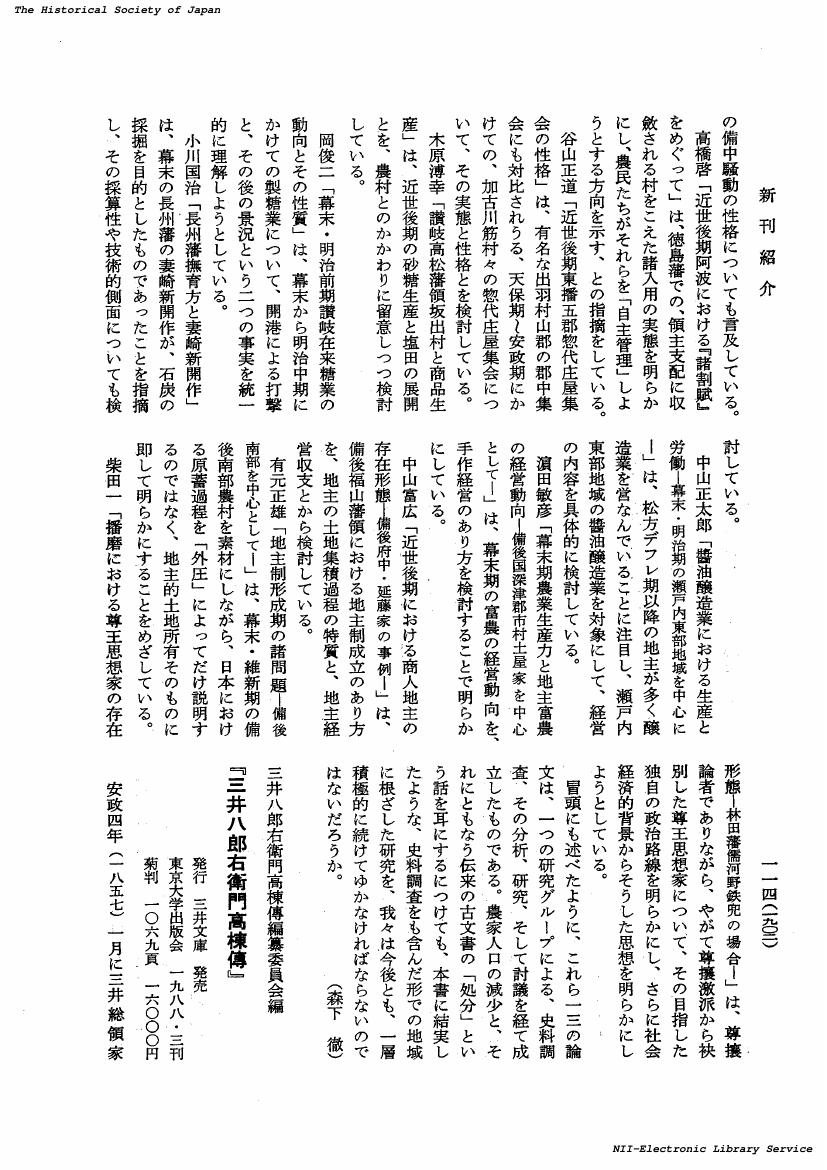13 0 0 0 OA 明治期紡績業における男女間賃金格差
- 著者
- 千本 暁子
- 出版者
- 経営史学会
- 雑誌
- 経営史学 (ISSN:03869113)
- 巻号頁・発行日
- vol.16, no.1, pp.65-87, 1981-04-30 (Released:2009-11-06)
2 0 0 0 OA 20世紀初頭における女性の有業率とM字型就労
- 著者
- 千本 暁子
- 雑誌
- 阪南論集 社会科学編 = Bulletin of Hannan University Social science
- 巻号頁・発行日
- vol.32, no.2, pp.1-15, 1996-09
1 0 0 0 OA 都市化と女性有業率 : 1920年国勢調査を用いて
- 著者
- 千本 暁子 Akiko Chimoto
- 出版者
- 同志社大学商学会
- 雑誌
- 同志社商学 = Doshisha Shogaku (The Doshisha Business Review) (ISSN:03872858)
- 巻号頁・発行日
- vol.63, no.5, pp.642-662, 2012-03-15
1 0 0 0 OA 近世鴻池家における別家制度の変容 ―通説の検証を通して―
- 著者
- 千本 暁子
- 出版者
- 経営史学会
- 雑誌
- 経営史学 (ISSN:03869113)
- 巻号頁・発行日
- vol.52, no.1, pp.3-23, 2017 (Released:2019-06-30)
Under the Edo period's hokonin system, the goal of a merchant house hokonin, a business employee having completed the minimum apprentice-type training period, was becoming an independent merchant — running a business under the master's name with some capital and goodwill — and being raised to bekke (non-kin branch family). During the Meiji period, this system transformed into an employment system based on employer–employee relations.Recently, there have been several studies concerning the hokonin system of individual merchant families and its transformation process, but they do not offer generalized discussions. Despite numerous published research outcomes about the House of Mitsui, a largescale merchant family, no research has generalized it as a hokonin system.Shigeaki Yasuoka compared the bekke-system of the Houses of Konoike and Mitsui, discussing their foresight into the modern era, especially the uniqueness of the House of Mitsui because of their innovative and modernized management. Today, Yasuoka's theory is an important, commonly accepted theory, making it challenging to discuss the commonalities between the hokonin systems of large-scale merchant families.This study attempts to verify Yasuoka's hypothesis using historical records of Konoike's hokonin published after Yasuoka's hypothesis was presented. We produced data on 256 individuals who joined the House of Konoike as hokonin between the end of the 17th century and latter half of the 19th century and clarified the trend of the ages at which they joined the family, began living outside the main family's premises, started their own business, and passed away. Moreover, we verified three of Yasuoka's hypotheses: (1) the House of Konoike had no family-run business aside from inheriting the existing bekke; (2) bekke was non-autonomous from the House of Konoike; and (3) management of hokonin at Konoike was “drifting management.” As a result, we revealed that the House of Konoike also implemented pragmatic management much like the House of Mitsui.
1 0 0 0 OA 一九九五年の日本経営史
1 0 0 0 OA 三井の長期勤続奨励策の史的考察
- 著者
- 千本 暁子
- 出版者
- 経営史学会
- 雑誌
- 経営史学 (ISSN:03869113)
- 巻号頁・発行日
- vol.23, no.4, pp.1-23,i, 1989-01-30 (Released:2010-11-18)
- 被引用文献数
- 1
The traditional years from the preindustrial Edo era in Japan to the Meiji era saw changes in employment relationship While not a few of the current practices can be traced back to the apprentice system of Edo merchant houses as, we recognize prototypes of our long-term employment in their live-out system and branch family system applied to executive employees.The apprenticeship system was essentially educational system whereby apprenticed children were disciplined until becoming full-fledged, independent merchants. Then, we have to ask why and how the merchant houses in the Edo era encouraged further long-term service from their fully qualified personnel long after their term of education. By the late Edo era, on the other hand, the word “apprentice” was often applied to petty servants and day laborers. What effect did this disintegration of the apprentice system have on the long-term service of highly skilled and potentially independent personnel? This article offers answers to these problems as it proceeds with the analysis of the sequential changes in the series of tactics the Mitsui House employed as it tried to secure long-term service of its high-ranking personnel.The Mitsui House apparently deliberated on and did deploy a succession of flexible stratagems in the face of changes within the House as well as in society. When the House underwent aggrandizement in the Edo era, the utmost effort went into securing the stable service of able personnel. Apprenticeship in any merchant house was a highly selective process and quite a few failed to fulfill their term of service and this competitiveness among the peers was quite a stimulus in the training of skilled personnel.As a result of Meiji restoration, the practice of having personnel changed in such way that the role of employees became stratified and they received their salary in cash according to the newly-introduced graded salary system. This new system worked as a good incentive to secure long-term service because loyalty and ability promised successive promotions with steady raise in salary.
- 著者
- 千本 暁子
- 出版者
- 公益財団法人 史学会
- 雑誌
- 史学雑誌 (ISSN:00182478)
- 巻号頁・発行日
- vol.97, no.11, pp.1902-1903, 1988-11-20 (Released:2017-11-29)
1 0 0 0 IR 明治期紡績業における通勤女工から寄宿女工への転換
- 著者
- 千本 暁子
- 出版者
- 阪南大学
- 雑誌
- 阪南論集 社会科学編 (ISSN:03881814)
- 巻号頁・発行日
- vol.34, no.2, pp.13-26, 1998-09
- 被引用文献数
- 1
1 0 0 0 OA 日本における工場法成立史 ―熟練形成の視点から―
- 著者
- 千本暁子 ちもとあきこ
- 雑誌
- 阪南論集. 社会科学編
- 巻号頁・発行日
- vol.43, no.2, pp.1-17, 2008-03
- 著者
- 千本 暁子
- 出版者
- 社会経済史学会 ; 1931-
- 雑誌
- 社会経済史学 = Socio-economic history (ISSN:00380113)
- 巻号頁・発行日
- vol.82, no.2, pp.175-197, 2016
- 著者
- 千本 暁子
- 出版者
- 社会経済史学会
- 雑誌
- 社会経済史学 (ISSN:00380113)
- 巻号頁・発行日
- vol.82, no.2, pp.175-197, 2016


